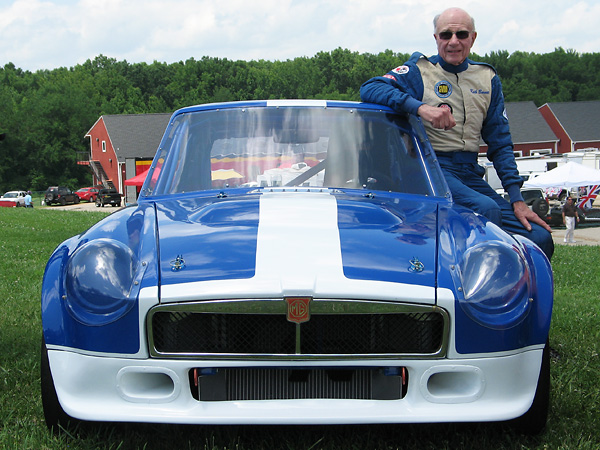
Keith Burnett's MGB GT V8 Race Car
Owner: Keith BurnettBritishV8 UserID: fastman
City: Churchville, Virginia
Model: 1972 MG "MGB GT V8"
Built by: owner.
Background Info
Keith Burnett has been competing in various events with British sports cars since
the early 1950's. Over the years Keith has driven many of the iconic British race
cars, but he has particularly been associated with Turner Sports Cars and Landar
Racing cars. Early in his engineering career, Keith built a special GT Turner Climax
which he raced successfully in England. Now, those familiar with Turner Sports Cars
will know that the company cast a remarkably long shadow for its height. For this
company, racing was always a higher priority than mundane requirements like driver
comfort or cargo capacity. Total production was only about 600 cars, but a majority
of Turners were raced. They were quite competitive in the lightest (small
displacement engine) Production classes up to 1500cc.
During the 1980's and 1990's, career and family responsibilities pushed racing
to the back burner, but eventually Keith returned to the sport and to the cars
he was most comfortable with. A 1961 Turner Mk1 with a 1100cc BMC A-series engine
(one of about 40 built) followed by a 1958 Turner 950S (one of about 170 built)
kept Keith's attention for five years. Keith was the Sportscar Vintage Racing
Association's (SVRA) Group-1 champion in 2003, driving his Turner Mk1.
In 2004, Jerry Richards invited Keith to race his MGB GT V8. Keith drove Jerry's
MGB GT V8 to a 3rd Place finish in the Gold Cup race held at Virginia International
Raceway. Later, Jerry also invited Keith drive it at Watkins Glen in the Collier
Cup race. Keith placed second overall, close behind Les Gonda in his MGB GT V8.
Following a conversation with Jack Woehrle, Technical Director of the SVRA,
Jerry suggested that if we could get a few V8 MG's racing in SVRA events then
the SVRA would include a class for MGB V8 cars in Group 8. Les Gonda and Jerry
were keen to do this and suggested that Keith should build a V8. Les invited Keith
to try his car during practice days at Summit Point raceway and Keith was impressed
enough to decide to build a V8 of his own.
In early 2006, Keith purchased this 1972 MGB GT from Bob Lassiter as a running and
driving street car. The 1800cc engine was removed and the car was stripped down to
a body shell in just one week. After scraping off all the mastic sound deadening
material, the shell was sent out for media blasting and a good coat of primer. It
didn't need much rust repair, so before long it was ready for installation of a roll
cage. Although Keith had a very clear picture of what he wanted, actual fabrication
of these structures is best left to an expert fabricator. Who better than James Bowler
of Weldone Inc. in nearby Richmond Virginia! (James' own MGB GT V8 racecar can be
seen elsewhere on this website.) Keith and James worked together to achieve a
particularly lightweight and stiff structure.
One of the next steps of the process was to get a custom rear axle built and installed.
Keith saved himself headaches by working with Abacus Racing in Virginia Beach.
Abacus orders and installs so many custom axles that they're very efficient at it.
They coordinated the work of the axle housing specialists at Currie Enterprises and
the axle shaft specialists at Moser Engineering. Abacus also engineered and installed
shock absorber mountings on the body shell. But Abacus is better know for engine
building. Indeed, that was their main role in the project. Abacus prepared the engine
block, a job that included re-sleeving the cylinders to comply with class rules.
Abacus also blueprinted and assembled the engine, and tuned it on their dynamometers.
Other key suppliers deserve special mention: John Targett of Targett Motorsport was
extremely helpful with a diverse range of parts including most of the fiberglass
'Sebring' body panels and even the made-in-England exhaust headers. Pegasus Racing
and Speedway Motors were the main supplier of fasteners and other small hardware.
The respective suppliers and manufacturers of other specialized racing components
are mentioned below.
Unfortunately, Keith has retired from racing due to health problems and has decided
to sell his MG. If you're interested in purchasing it,
please see Keith's classified
ad on the BritishV8 message board.
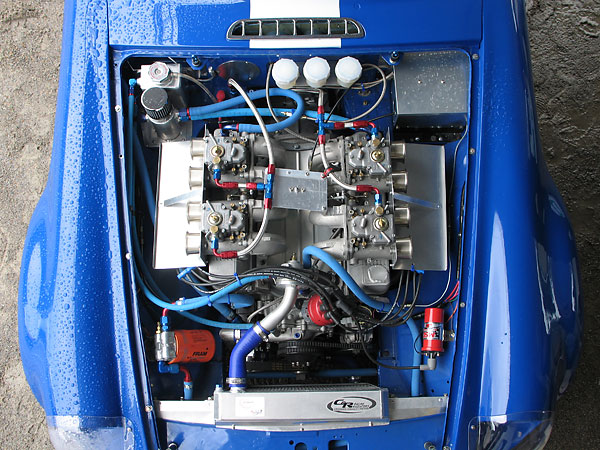
Late Rover block (with 4 bolt main bearings, etc.) professionally built to full racing specification.
Features and Specifications
| Engine: | late Rover block (with 4 bolt main bearings, etc.) professionally built
to full racing specification. T-top style cylinder liners with 3.5" bore
diameter to comply with class rules. O-ringed block decks. Forged pistons
and steel connecting rods. Race-prepped crankshaft. Big valve, ported and
flowed cylinder heads. 12.7:1 static compression ratio. New (not reground)
Piper racing camshaft. Adjustable rocker arms. Weber 50DCOE carburetors.
Mallory Unilite distributor. MSD6AL ignition system (with 6600rpm
rev-limiter chip installed) and MSD Blaster 2 coil (part# 8203). Taylor Spiro Pro
8mm ignition leads. The cylinder heads, crankshaft, manifolds, etc. were
race-prepped by John Eales in England, and the engine was built-up by
Abacus Racing in Virginia Beach, VA. |
| Cooling: | C&R custom aluminum radiator. Canton coolant header tank with 7psi cap.
A restrictor plate is used in lieu of a coolant thermostat. |
| Lubrication: | eleven quart dry sump lubrication system with TDC Oil Pumps 3-stage external oil pump,
rear mounted oil tank, Aeroquip plumbing, etc. Dual "half width" (6.625" wide)
13-row Mocal oil coolers are mounted on either side of the radiator. |
| Exhaust: | 4-into-1 headers into open pipes, exiting ahead of the righthand rear wheel. |
| Transmission: | modified Borg-Warner T5 5-speed transmission (Ford type) with 0.80:1 fifth gear.
Tilton steel flywheel, twin plate clutch, and hydraulic throw-out bearing. |
| Rear Axle: | 8" Ford rear end, with housing narrowed by Moser Engineering and fitted with Moser
driveshafts. Currie aluminum carrier. Ford limited slip differential. 4.10:1 final
drive ratio. |
| Front Susp.: | MG Limited (a.k.a. Killer Beez or Dick Luening) 1" lowered spindles.
Moss-supplied 660 lbs/in competition springs, slightly shortened to suit.
Modified lever shocks with competition valves.
Fab-Tek (a.k.a. Dave Headley) anti-sway bar, modified to suit with larger links
and Heim joints. |
| Rear Susp.: | stock GT rear springs, modified by removal of three of the seven original leafs to
achieve lower spring rate and ride height. Panhard bar.
Carrera telescoping shocks with 6" stroke length (part# 3265. Note: Carrera's
"32 Series" has been replaced by QA1's "75 Series".) A Fab-Tek anti-sway bar was
been purchased and modified to suit the car. (It wasn't installed when the photos
below were taken. The modifications were made to suit the Ford axle. Also, larger
links and Heim joints were desired.) Upper radius rod. |
| Brakes: | (master) Tilton pedal assembly with balance bar, with remote control from cockpit. (front) custom, vented, fully floating 11" rotors. Custom Outlaw 4-piston billet, radial mount calipers. (rear) 10" Ford drum brakes with competition linings. |
| Wheels/Tires: | Compomotive (Minilite-copy) 15" wheels with Toyo Proxes RA1 225/50ZR15 tires.
(Also have four new genuine Minilite wheels for a second set of tires.) |
| Electrical: | lightweight Nippondenso alternator. Lightweight racing battery. Separate toggle
switches for the following circuits: ignition, fuel pumps, Cool Shirt, and brake lights.
(The brake light toggle switch is only used when waiting for the start of a race
when on a slope as there is no parking brake and I don't want to discharge the
small battery. There are two seperate fuel pump switches. The car's two fuel pumps
pull fuel from the two rear corners of the fuel cell. One pump is usually sufficient,
but if fuel level is getting low both pumps are switched on. Each of these
toggle-switched circuits are individually fused.) Correct 6-terminal master cut-off
switch. (Per FIA safety standards, one set of switch contacts disrupts power to the
ignition coil. A second set of switch contacts grounds the alternator through a 3 Ohm
resistor. Much larger contacts disconnect the positive battery cable.) |
| Instruments: | (left to right) AutoMeter Pro-Comp tachometer and Pro-Shift shift light (set for 6600rpm).
AutoMeter Sport-Comp coolant temperature, oil pressure and oil temperature gauges. |
| Fuel System: | ATL 12 gallon fuel cell. Twin Facet fuel pumps. Filter with replaceable element. |
| Safety Equipment: | full rollcage built by James Bowler (Weldone Inc.) Kirkey aluminum racing seat
(model 41700, weighs 12.45#) with Crow 6-point latch-and-link safety harness.
Genesis Technologies blue ribbon-style 18x18 window net. Firecharger central fire
extinguisher system. Sweet Manufacturing splined, quick release hub (part# 801-70055)
on a Momo steering wheel. |
| Body: | Sebring fiberglass front fenders, rear flares and rear valances. Fiberglass bonnet
with custom bulge to suit Weber carburetors. Fiberglass front air dam. Fiberglass
rear hatch spoiler. Sebring headlamp covers. Polycarbonate windows. MG "Tahiti blue"
paint with distinctive white striping. |
| Weight: | less than 1950lbs., before adding ballast to meet SVRA class 8A requirement. |
| Racing Class: | SVRA Group 8 "A-production". (The car has passed technical inspection and an SVRA
log book has been issued, but it hasn't been raced yet as of publication of this
article.) |
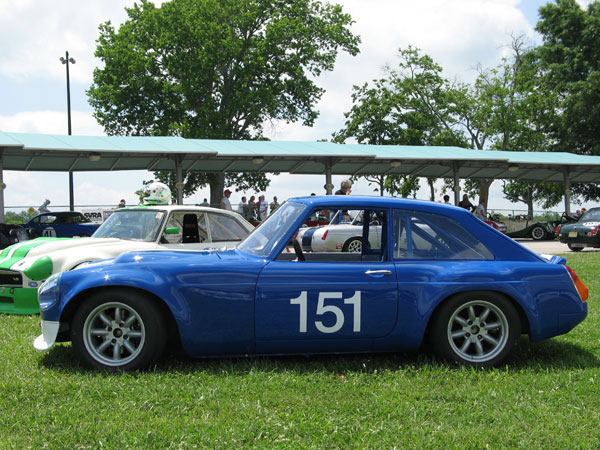
Ready to race!
Mechanical Details
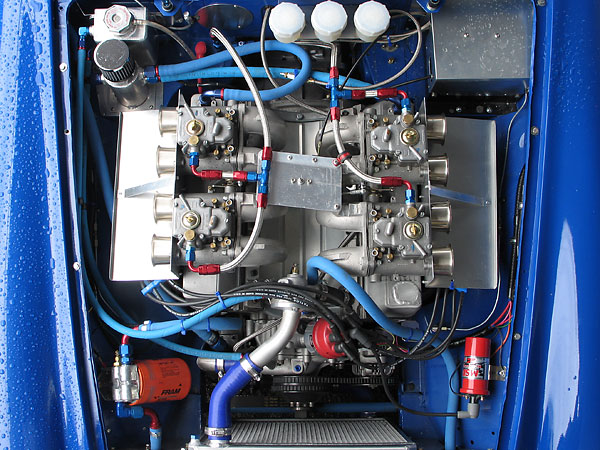
Four Weber 50DCOE carburetors mounted on JE Developments swan neck manifolds.
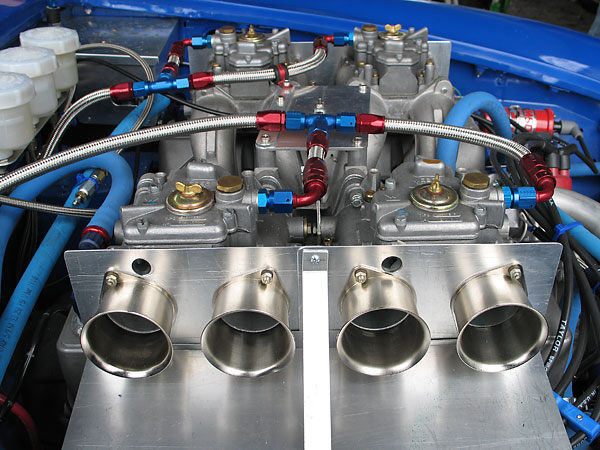
Did you know DCO stands for Doppo Corpo Orizzontali? (That's "double body horizontal draught" in Italian.)
The "50" in 50DCOE indicates the bore diameter. The "E" indicates they have a cold start mechanism.
(The cold start mechanism isn't being utilized in this particular case.)
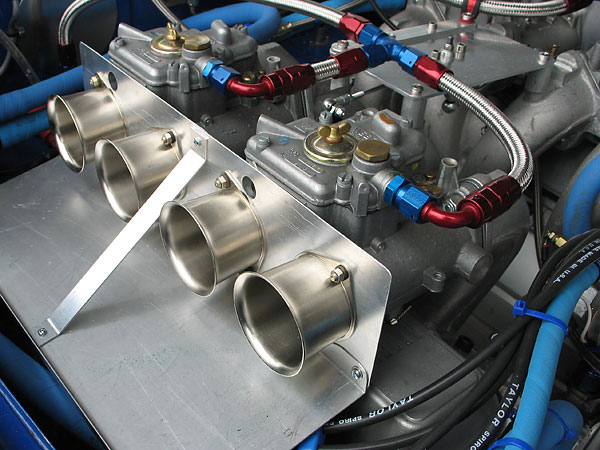
Stainless steel velocity stacks streamline airflow into the carburetor bores.

John Eales of JE Developments ("JED") developed these swan neck manifolds.
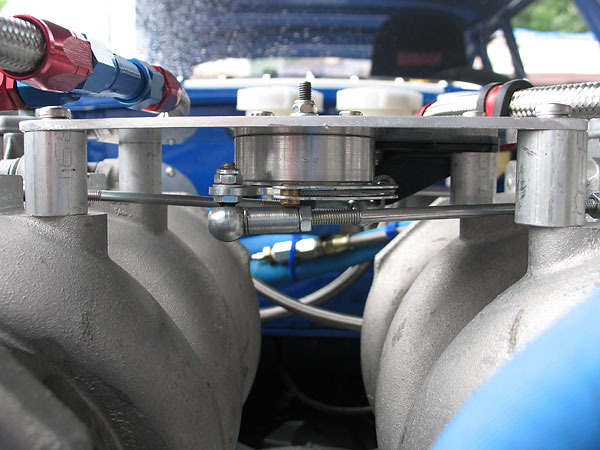
Throttle cable and linkage...
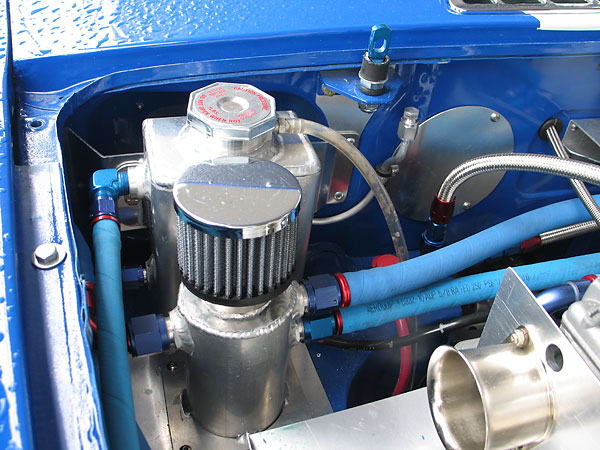
Canton coolant header tank with 7psi cap.
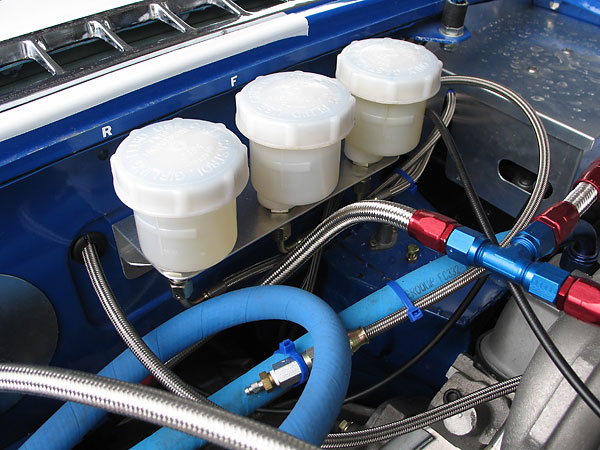
Remote reservoirs for the brake and clutch master cylinders.
Foreground: bleed fitting for hydraulic throw-out bearing.

Foreround: throttle cable. Background: a spacer plate between transmission and bellhousing accomodates
the longer input shaft on a Ford-spec T5 transmission (compared to a Chevy-spec unit.)

Aluminum cover for the Tilton master cylinder set.

Mallory Unilite distributor.
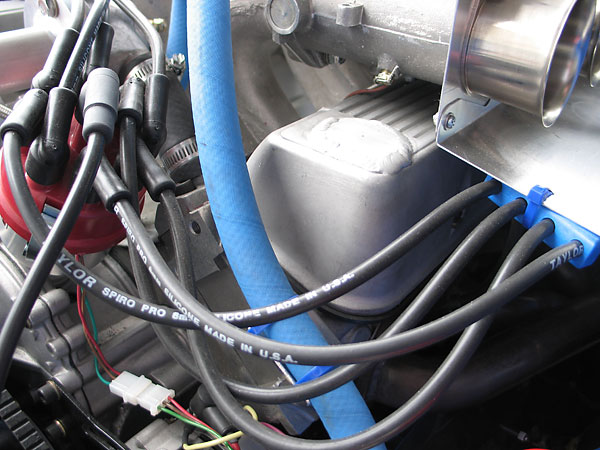
Taylor Spiro Pro 8mm ignition leads.

Lightweight Nippondenso alternator.
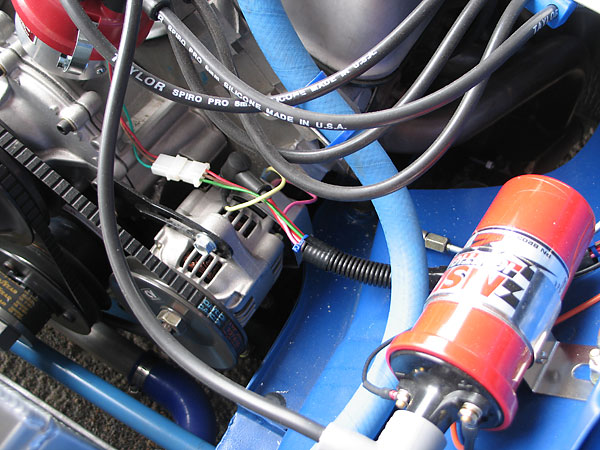
MSD Blaster 2 coil (part# 8203).

C&R custom aluminum radiator.

A simple filler strip ducts airflow between the stock slam panel and the radiator core.
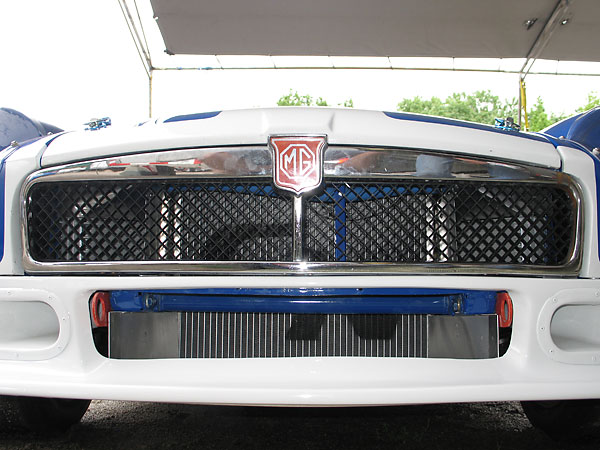
Ductwork between the front air dam and radiator core maximizes cooling system effectiveness.

Dual "half width" (6.625" wide) 13-row Mocal oil coolers are mounted on either side of the radiator.

Cooling airflow from the oil coolers is ducted into the wheel wells.
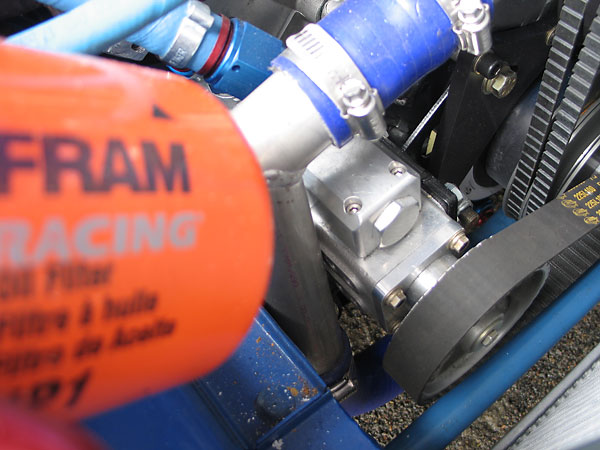
TDC Oil Pumps (from Fast Forward Components) 3-stage external oil pump.
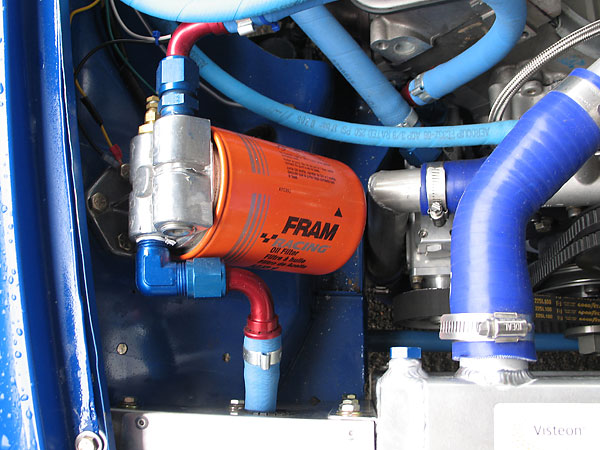
Fram Racing oil filter, model HP1.

4-into-1 through-the-wing headers.
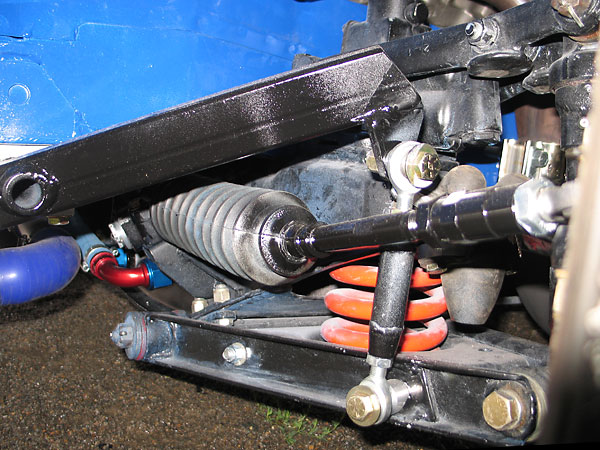
SVRA rules forbid almost any change to the front control arms, but the anti-sway bar is unrestricted.
Killer Beez dropped spindles lower the front suspension one inch. At the same time, they move the
front suspension's roll center upward and change its camber gain characteristics. Some tuning is
required to minimize bump and roll steer. On Keith's car, the steering arms have been swapped
(right for left) and redrilled for use with Heim joints in lieu of tie rod ends to facilitate this.

Ford 8" rear axle, shown with (foreground) custom Panhard bar and (background) modified GT rear
springs with four leafs instead of seven. Also visible: Carrera telescoping shocks. They're
inverted so that proportionally more of their weight is unsprung instead of sprung.
Enjoying this article? Our magazine is funded through the generous support of readers like you!
To contribute to our operating budget, please click here and follow the instructions.
(Suggested contribution is twenty bucks per year. Feel free to give more!)
Interior
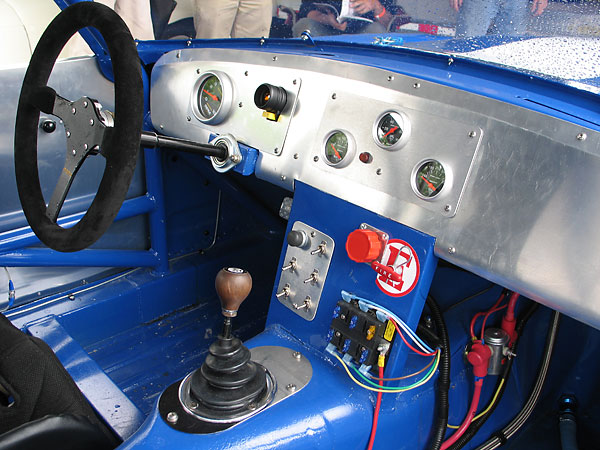
Left-to-right: AutoMeter Pro-Comp tachometer and Pro-Shift shift light (set for 6600rpm),
AutoMeter Sport-Comp coolant temperature, oil pressure and oil temperature gauges.

Kirkey aluminum racing seat (model 41700) weighs 12.45#.
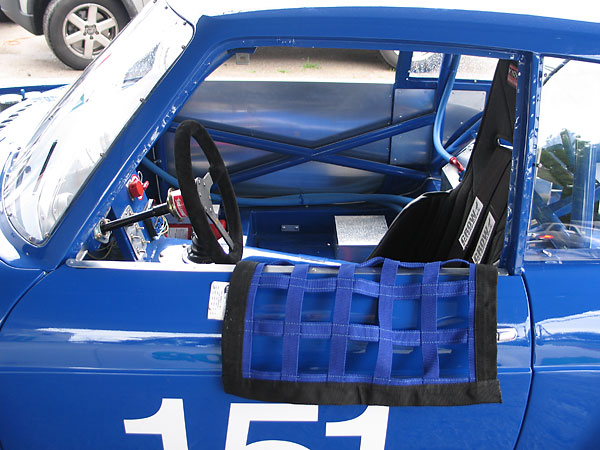
Genesis Technologies blue ribbon-style 18x18 window net.

Crow 6-point latch-and-link safety harness.

Note the beefy crosstube mounted to the floorboard foreward of the seat.
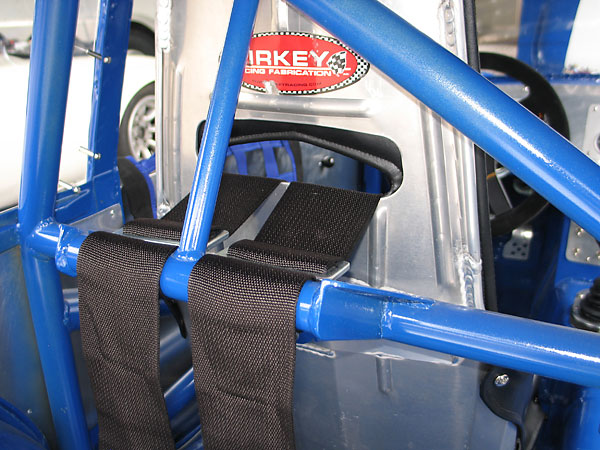
The mounting height of shoulder straps is critical to spinal protection.

Sweet Manufacturing splined, quick release steering wheel hub (part# 801-70055).
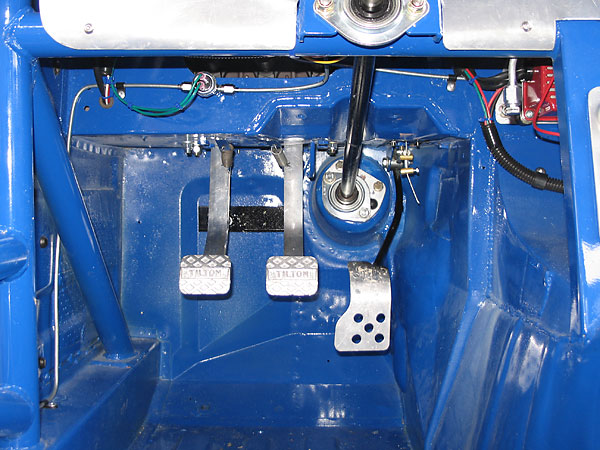
The steering column is mounted on two pillow blocks.

The firewall-mounted pillow block is mounted via an angled billet aluminum spacer.

Brake light switch.

Separate toggle switches for the following circuits: ignition, fuel pumps (2), Cool Shirt, and brake lights.

Foreground: ignition kill switch wired per FIA safety standards: one set of switch contacts disrupts power
to the ignition coil. A second set of switch contacts grounds the alternator through a 3 Ohm resistor.
A much larger set of contacts disconnects the positive battery cable.

Tie-wrapped to the cage brace, inside plastic tubing, the 3 Ohm resistor for the alternator grounding circuit.

MSD6AL ignition system with 6600rpm rev-limiter chip installed. (Foreground: starter solenoid.)

Firecharger centralized Halon fire extinguisher bottle.
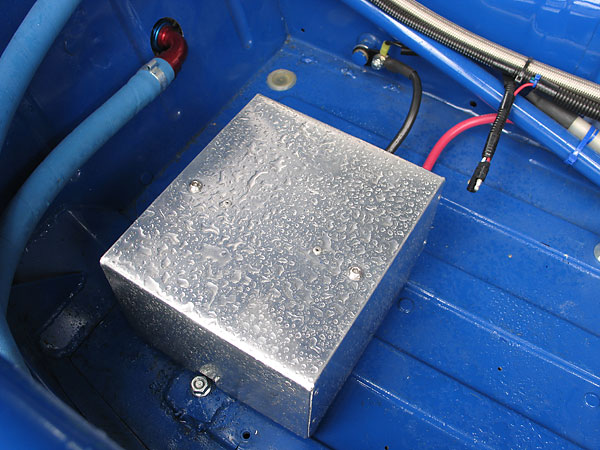
A lightweight AGM ("absorbed glass mat", a.k.a. "dry cell") racing battery is mounted under this cover.

A twelve gallon ATL fuel cell is mounted under this fireproof aluminum cover...
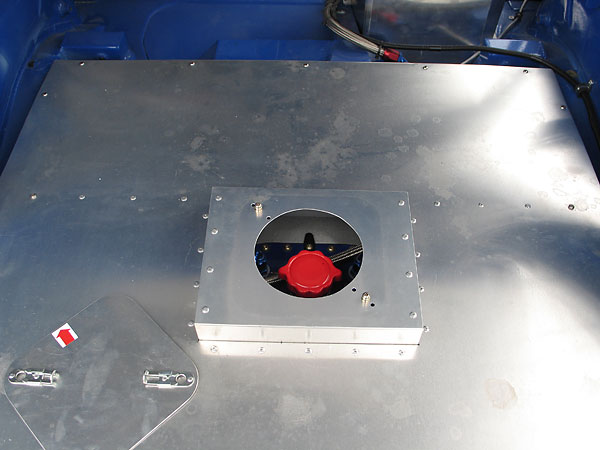
Fueling is easily accomplished by removing this lid.

The lid is retained by two Dzus "1500 Series" sliding latches and bushings.

This photo shows how the Dzus "1500 Series" sliding latch mechanism works.
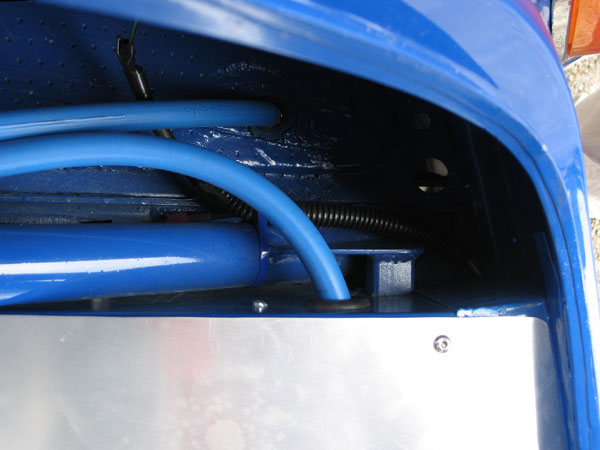
The fuel cell vent line runs up to the top of the roll cage, then back down through the floorboard.

The reservoir for the eleven quart dry sump lubrication system is mounted under this cover.
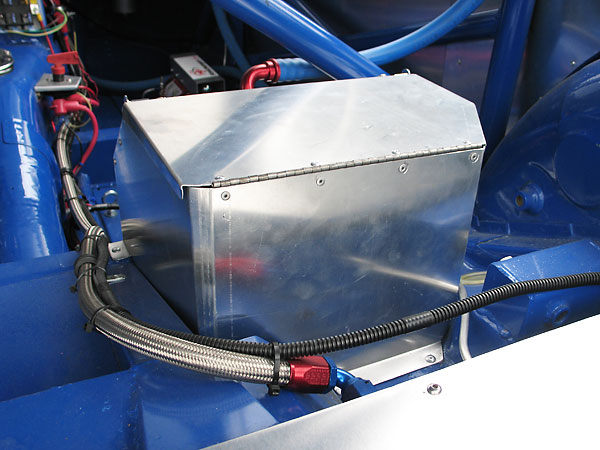
A hinged lid makes access to the fittings easier.

Underneath the plumbing, you can see the battery shelf has been modified for axle clearance
and a raised section covers an off-center radius rod that restricts pinion angle change.
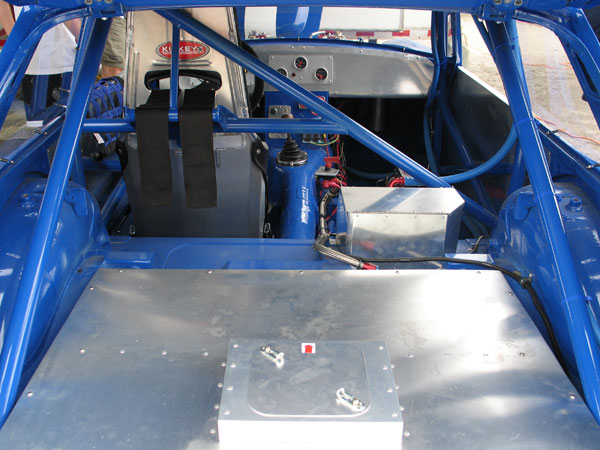
The rollcage was built by James Bowler of Weldone Inc., in Richmond Virginia.
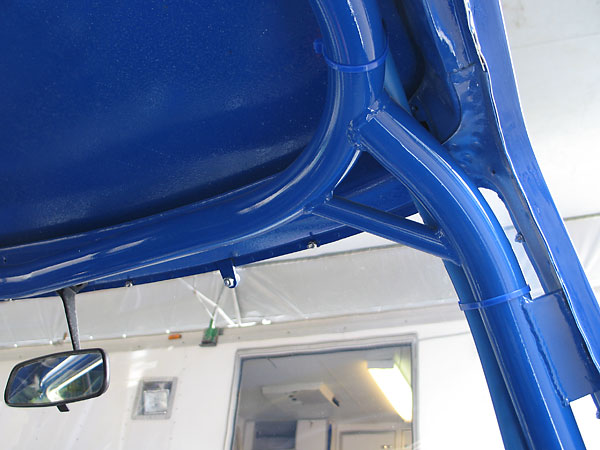
The rollcage synergistically achieves extra strength through corner bracing and strong tabs to the bodyshell.

A small tab, in the right place, can add a lot of strengh. But lightening holes don't necessarily
remove strength. Notice the lightening holes in the door hinge.

One more example...

A good look at a main hoop mounting plate.
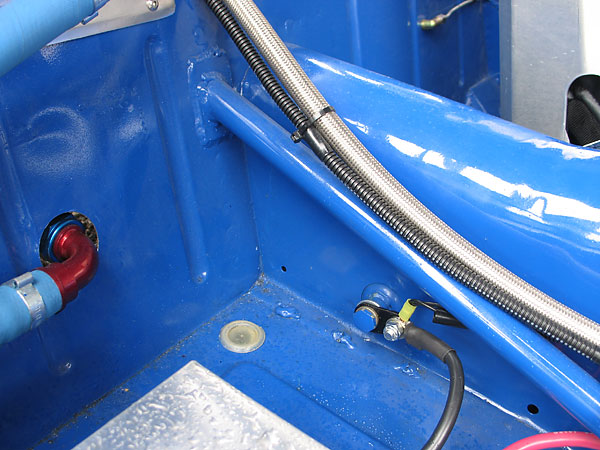
This brace helps spread the load of the upper suspension radius rod.
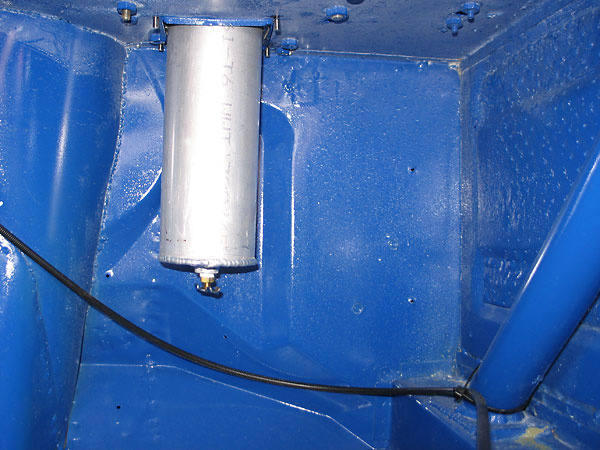
The cooling system and crankcase share this generously-sized, custom, breather tank.

The folded flange at the top of this aluminum door panel blanks the window slot.

Quite a lot of weight was removed from the rear hatch, especially by replacing glass with plastic.

Exterior

The thing to remember about "Sebring flares" is that if they were understated, they wouldn't be
period correct. Don't they make a strong, masculine statement!

The color is MG's "Tahiti Blue", obviously complemented nicely with distinctive white striping.

Fiberglass front air dam, complete with brake cooling ducts.
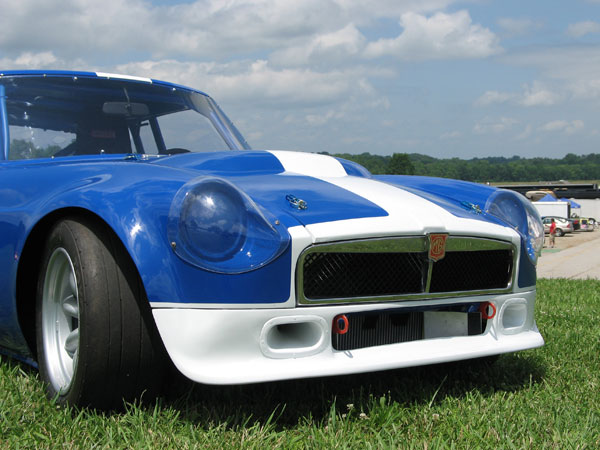
Sebring headlamp covers look cool even when there aren't any headlights to cover.

Slide type captive hood pin assembly. (7/16" pin, 1/4" clevis, stainless steel retainer plate.)

This custom fiberglass hood bulge also makes no apologies to "purists"!

Fiberglass rear hatch spoiler and Sebring style rear valance.
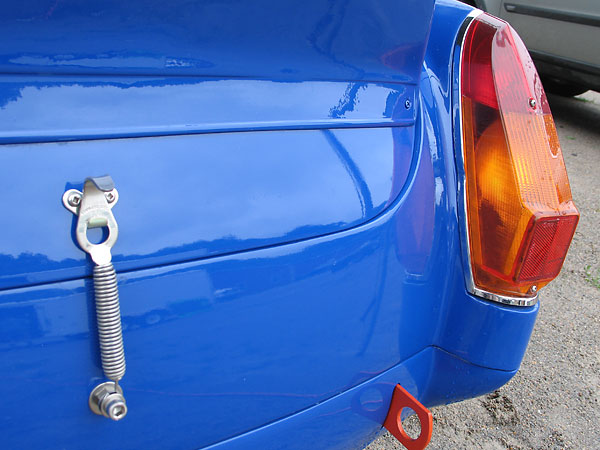
These fasteners are called "Terry body springs".

All of these fiberglass body parts (and the headlamp covers) came from John Targett at Targett Motorsports.
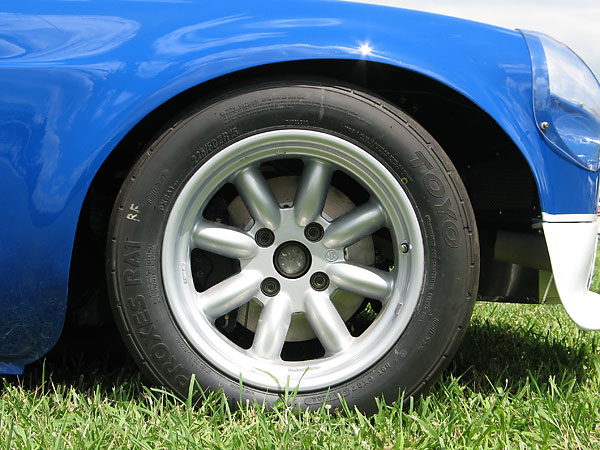
Compomotive 15" wheels.
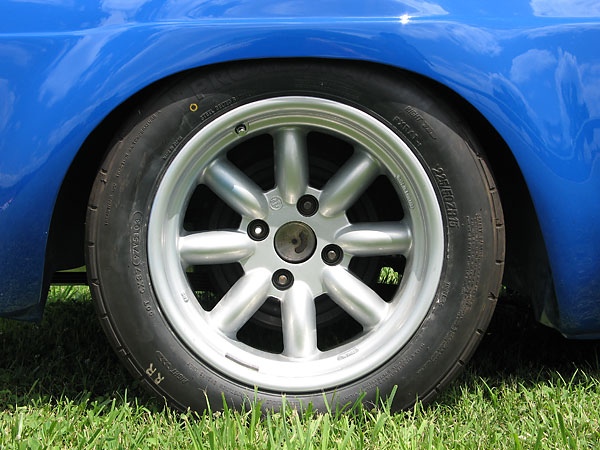
Toyo Proxes RA1 225/50ZR15 tires.

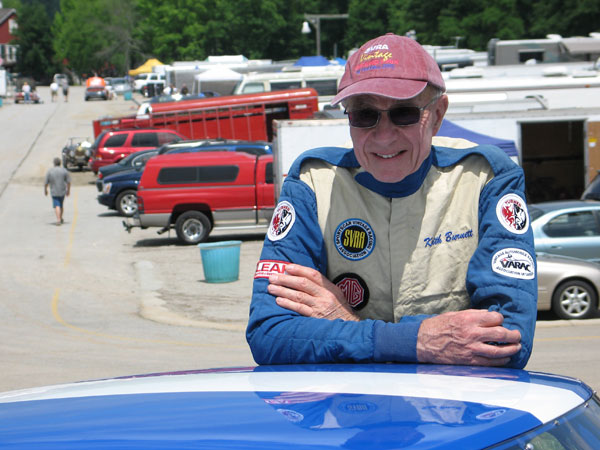
All photos shown here are from June 2009, when BritishV8 viewed the car at The Heacock Classic Gold Cup at Virginia International Raceway. All photos by Curtis Jacobson for BritishV8 Magazine, copyright 2009. All rights reserved.



